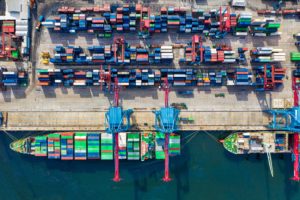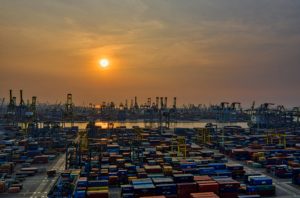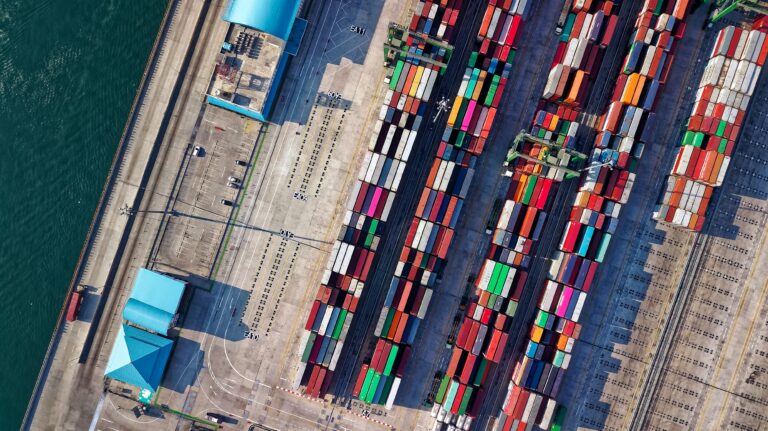When leaders from around the world met in Glasgow, Scotland, at the beginning of November for the COP26 summit, UN Secretary General António Guterres opened the proceedings with a stark warning. “Either we stop it – or it stops us,” he cautioned. “We are digging our own graves”
As the world’s media watched on with interest, no doubt many supply chain leaders were tuning in, too, for the supply chain sector is at the centre of the debate.
Climate change impacts many aspects of a company – production costs, delivery speed, and the quality of goods delivered to the end-user. The irony, though, is that the supply chain and shipping industry contributes to a staggering 80% of the GHG emissions causing climate change. Therein lies the challenge for the supply chain sector.
A month or so earlier, supply chain leaders converged for a Kinaxis virtual event to debate that challenge, as well as the role of sustainable supply chains, and more specifically how the ‘circular economy’ could be a game-changer in the fight against climate change.
Attendees of the Big Ideas in Supply Chain Summit heard how the role of supply chain professionals could be pivotal and circularity in the supply chain in particular presents a giant untapped opportunity for international climate action.
It is widely accepted now that the ‘normal’ supply chains of material use – produce materials, use them, and then discard them – are wasteful and damaging to our planet. This linear ‘take-make-use-dispose’ model has led to our throwaway society. In the circular model, economic growth is decoupled from material consumption. In a circular economy, supply chain participants take ownership of their products and services throughout their network, designing strategies to bring resources full circle for re-use without quality degradation – and with an aim of zero waste.
Success of measures
Measurement is critical as a tool to collaborate the sustainability credentials of the participants within your supply chain. And the old adage that you can’t change what you can’t measure has never been more apt. “Part of my work with the North American Capital Equipment Coalition is to really go and drive an industry standard for the way that we do carbon accounting,” explains Microsoft’s Paul Clark. “There are several models that are out there, but there’s not really one adopted standard. If you look at a supply chain, you’re five steps removed from receiving the product. All five companies on the left-hand side of you could have a different way of doing their carbon accounting. Just think about translation from one company to the next to the next to the next – those calculations could become meaningless over time. That’s why my team developed the Microsoft Sustainability Calculator. In the end, as we look at all of these things in a circular economy versus a linear economy, we’re going to have to really develop a metric and a way to measure this from dirt to dirt because these products go through cycles, and will go through loops, and eventually get returned to some type of end state, even albeit a raw material. We’re also going to need greater transparency – we’re going to have to be able to report these things openly, share our calculations, be open for scrutiny, so that all companies can come together and actually drive the standard forward.”
“We know that anywhere from 60-80% of a company’s GHG emissions come from its supply chain,” reports Polly Mitchell-Guthrie, Vice President, Industry Outreach and Thought Leadership at supply chain planning specialist Kinaxis.
Mitchell-Guthrie chaired the fascinating panel debate that featured sustainability experts from Microsoft, Optel, Cranfield University and one of the world’s leading IT/networking suppliers. “In the KPMG 2021 CEO Outlook, leaders cited three risks to future growth: cybersecurity; supply chain; and sustainability,” Mitchell-Guthrie continues. “And this is one of only many recent rankings or polls that show climate change, supply chain and sustainability at the top of the corporate agenda.”

The Kinaxis expert went on to spotlight some other statistics to set the scene. The bad news is that in a recent Pew Center global survey 72% of individuals are concerned that sustainability and climate change will affect them and personally harm them in their lifetime. The good news is that 80% of those people said that they were willing to make changes in their personal or their work lives. For Mitchell-Guthrie, there exists a gap between the individual commitment and the corporate commitment. “How do we make this operational?” she asks. “According to the Chartered Institute of Procurement & Supply (CIPS), 80% of supply chain managers stated that they either had ‘no involvement’ in planning for sustainability, ‘little involvement’, or were ‘unaware of any corporate sustainability strategy’?”
When the impact of the Covid-19 pandemic was still escalating, many people expected the crisis to dampen companies’ enthusiasm for investing in supply chain sustainability. However, the State of Supply Chain Sustainability 2021 report from the MIT Center for Transportation & Logistics found that more than 80% of survey respondents in this year’s report claimed the crisis had no impact or increased their firm’s commitments to supply chain sustainability. Furthermore, executives were “undeterred” by the crisis; 83% of those interviewed said Covid-19 had either accelerated supply chain sustainability activity or, at the very least, increased awareness and brought urgency to this growing field.
So, why exactly is supply chain sustainability so important? “There is no Planet B,” suggests Louis Roy, President & Founder of Optel Group, which supplies traceability software used in many industries, including for supply chains. “More and more, we are facing a demand problem and we need to rebalance the supply chain while at the same time considering the harm we are doing to our ecosystem.”
Of course, we know that fires, flooding, drought and all kinds of other environmental issues are disrupting supply chains globally – and climate change is predicted to be even more disruptive than Covid-19. So, how can the circular economy mitigate these kinds of risks?
“In our great wisdom as humans, we spent 250 years – ever since the Industrial Revolution – building this rather different model of the linear economy,” explains Sandy Rodger, who is currently conducting PhD research in circular economy at Cranfield University, following a +25-year career at Unilever and Diageo. “We take resources, turn them into some kind of product, use them typically just once, and then it becomes waste. And more than 90% of the economy works that way.

“What does the circular economy do? It begins to diversify the supply of your essential materials,” Rodger adds. “A lot of global supply chains in the linear economy are very centralised; it’s coming from one mine, one factory, on one ship.” That, he feels, is entirely unsustainable and places huge risk at the heart of the supply chain so when things do go wrong, as demonstrated by the pandemic, cracks in the system very quickly appear.
For obvious reasons in the past 18 months, we heard a great deal about supplier visibility and the need to pay more attention to suppliers. However, one challenge is that suppliers are often averse to sharing certain information. “When we start our carbon targets at Microsoft, we engage with our suppliers very early in the process,” reveals Paul Clark, General Manager of Cloud Engineering and Supply Chain Sustainability at Microsoft. “Our goal was to bring about a 55% reduction in Scope 3 emissions, but we can’t do that on our own. We need our supply chain, and we need our suppliers to be part of that journey. That’s why we put a sustainability clause in all of our contracts. We’re expecting that for every product that we purchase from our suppliers. And with that carbon data, we can track it all the way back to the source. And that’s worked very well.
Smarter by design
Optel’s Intelligent Supply Chain (ISC) is a traceability platform that is able to digitise supply chains from end to end. It captures data over the entire product life-cycle.
“Our technology stack empowers the data across the supply chain, providing visibility on operations and transparency from raw materials to consumers and beyond,” explains Louis Roy. “We all know the world is rife with environmental, economic and social problems. What few of us realise is that many of these issues arise because today’s supply chains lack visibility and transparency at every stage of the journey, from raw materials to consumer products.
“In addition to optimising available resources, facilitating the re-use of materials, authenticating products, and ensuring fair and sustainable trade, traceability allows companies to take control of their products’ carbon footprints. End-to-end traceability is the key to product life-cycle analysis, which leads to understanding and controlling the environmental and social impact of any type of product. For every industry, every product, at every level, traceability is the driver of a smarter, safer, more efficient, entirely connected global supply chain – an intelligent supply chain. It is the key to a more sustainable world.”
“We also took our top 10 suppliers by carbon count and we sat down with them to build individual sustainability roadmaps,” Clark reveals. “We look at factory locations and what type of electricity their factory is running on. Are there alternative manufacturing locations? We look at the manufacturing process, we look at logistics and shipping, etc, all with the goal of getting that carbon score down as much as possible over time.”
Clark is adamant that sustainability and carbon reduction are two areas where companies can really set aside their differences. “It’s less about competition and more about collaboration,” he says. “And getting that collaboration between suppliers is key. I really believe the model works because we’re all invested. We’re invested to battle climate change, we’re invested because we want to bring about these positive changes across the ecosystem. There are internal pressures, too. Every company is hearing from their customers; they’re hearing from their shareholders; they’re hearing from their employees. So the question is, what are you doing to reduce carbon emissions?”
The Microsoft sustainability leader feels that, in a circular model, there will be different incentives along the way that drive new revenue sources for suppliers as well as for Microsoft. Spending more than a billion dollars a year in hardware, he cites in particular waste from electronic products that could be mined from Waste from Electrical and Electronic Equipment (WEEE) to be re-used or re-purposed for a second or even a third life. “There may even be a premium for recycled electronics materials such as gold,” he predicts. “So even when you look at the cost of gold and all of the ore that comes out of the ground, there may be a premium paid for recycled content.”

“Your ultimate ambition may be to get your whole business into a circular model, but you can’t achieve that all at once,” suggests Rodger. “If you rely on recovering materials that have fallen into the municipal waste system, of cities, and so on, those systems change very slowly. So, it’s hard to get back [the materials] – you might get it in 10 years’ time but not next week. I think that the art of this is to look for the places where you can close the loop more easily, possibly working more with the B2B relationships than B2C relationships. The guys that crack the B2C relationships and get consumer buy-in, they’re the ones that are going to have a kind of explosive opportunity.”
Amid all of the doom and gloom predictions emanating from COP26, the consensus of the panel is that tomorrow’s world is going to be better than today’s world – and the application of bits and bytes and technology can contribute positively to that future. Humans are hugely creative beings, they agree, and we’re going to come up with all kinds of very clever ways to make the world a better place, one that is bound up with sustainability, because now more than ever we can see things that we perhaps couldn’t see before.
To find out more about Kinaxis supply chain planning software, please email media@kinaxis.com or or log on to the website at www.kinaxis.com/en







